Thursday, March 31, 2011
Dave's thoughts on Google's +1 release and SEO impact {worthy listening RT}
+1’s: the right recommendations right when you want them—in your search results. {pretty big news}
Say, for example, you’re planning a winter trip to Tahoe, Calif. When you do a search, you may now see a +1 from your slalom-skiing aunt next to the result for a lodge in the area. Or if you’re looking for a new pasta recipe, we’ll show you +1’s from your culinary genius college roommate. And even if none of your friends are baristas or caffeine addicts, we may still show you how many people across the web have +1’d your local coffee shop.
The beauty of +1’s is their relevance—you get the right recommendations (because they come from people who matter to you), at the right time (when you are actually looking for information about that topic) and in the right format (your search results). For more information about +1, watch this video: So how do we know which +1’s to show you? Like social search, we use many signals to identify the most useful recommendations, including things like the people you are already connected to through Google (your chat buddies and contacts, for example). Soon we may also incorporate other signals, such as your connections on sites like Twitter, to ensure your recommendations are as relevant as possible. If you want to know who you're connected to, and how, visit the “Social Circle and Content” section of the Google Dashboard. To get started +1’ing the stuff you like, you’ll need to create a Google profile—or if you already have one, upgrade it. You can use your profile to see all of your +1’s in one place, and delete those you no longer want to recommend. To see +1’s in your Google search results you’ll need to be logged into your Google Account. We’ll be slowly rolling out +1’s, starting in English on Google.com. If you can’t wait to start seeing +1’s, we’ll soon let you opt-in to the launch by visiting our experimental search site. Initially, +1’s will appear alongside search results and ads, but in the weeks ahead they’ll appear in many more places (including other Google products and sites across the web). If you’re an advertiser and want to learn more about how the +1 button works on search ads and websites, visit our AdWords blog. We’re confident that +1, combined with all of the social content we’re now including in search, will mean even better, more relevant results than you get today. Posted by Rob Spiro, Product Manager
Monday, March 28, 2011
Get The Internet Marketing Lifestyle You Deserve

Improve Your Online Marketing With The Help Of The Best SEO Company. Visit Us At http://www.melbourneseoservices.com .
Sunday, March 27, 2011
Am I seeing this right? #1 on Google.com.au for "seo services" ? What more proof do you need?
Thursday, March 24, 2011
We're beating @garyvee 's press release. Just snapped this:
Click here to see the press release.
Video Ranking Tips To Draw More Viewers
It is not enough to just create a great video, post it on YouTube, and just wait for things to happen. You have put some effort into making your video rank or stand out from the crowd. There are many things to consider that will affect your video’s rank in a search.
The following factors play into how Google’s algorithm ranks a video. More of each is better and results in a higher video ranking.
- Backlinks: Links to your video from other web pages.
- Embeds: People are allowed to embed your video into their webpage unless you specifically disable this for your video.
- Views: The number of times the video has been viewed.
- Ratings: People are allowed to rate a video from 1 to 5 stars
- Comments: Comments from viewers are allowed on videos unless you specifically disable this for your video.
- Age: The age of your audience.
- Playlists: YouTube users can create playlists that include any public video on YouTube.
- Channel Views: This is the number of visits to your YouTube channel where your videos and information are displayed
- Subscribers: Your subscribers are those who have signed up to be notified of new content posted in your channel.
Channel Secrets:
- Selecting your username: When choosing a username be sure to choose something that is related to what your videos will be about. You want to have a sense of branding to what you are posting. When your username has some relevance to your video’s content, viewers are more likely to click on your username to browse your channel and view more of your videos.
- Change your background image: Brand your YouTube channel as much as you can. If you have a logo then use it as your background and include the URL of your website as well.
- Set your channel type: The default channel type is Youtuber. You can choose other channel types such as Guru. There are awards for most viewed, most subscribed, etc. It is much easier to win these awards if you choose Guru because less people will have chosen that and you’ll be competing with a smaller group than the default.
- Tell viewers to subscribe: Be sure to call your viewers to action and tell them to subscribe to your channel. You can put this call to action in the description of your videos and your channel itself. Many users ask others to subscribe at the end of their videos and if done in a tasteful manner can be very effective.
- Include your URL wherever possible: You can put your URL at the end of your videos or as a subtext throughout your video. You can also put it in the description of each video as well as your channel description. There is also an actual place for you to put a URL to your website on your channel information section. Remember that increasing video views will eventually increase web traffic if the viewers have a link to your website.
So do you believe that proof lies in video ranking? Before you answer that, take this challenge. Create or use a video that you think is amazing. Then integrate these tips when posting the video. Come back and share your thoughts, ideas and findings with this challenge. We dare you!
Check out our Youtube channel and see how the pros do it.
Other Posts You May Be Interested In:
Wednesday, March 23, 2011
How I Started Selling Information Online: What It Takes To Become An Infopreneur {solid}
I’m an Internet infopreneur. The term itself needs some explaining upfront, so let me begin with that. An infopreneur is an “information entrepreneur”, someone who turns words (or more specifically, information) into income – in a number of innovative ways. I’m an infopreneur who uses the Internet as a medium for distributing and monetizing information.
How Did This Avenue Of Making Money Online Appeal To Me?
It all began when I read a short free report – around 11 pages – by famous author and real estate specialist Robert Allen. In that report, Bob explained the real value of building a business around information and infoproducts. Two things about it attracted me immediately.
#1 – You can add value to the world through your words. There is a deluge of data all around. But data, while helpful, isn’t quite valuable. What’s really valuable is INFORMATION. It turns what was a noisy cacophony into a melodious symphony, and information is what people in need or search of it will pay you for – happily.
#2 – You can get paid forever for work done once. Think about an author who writes a book. Let’s say it takes a year of hard work to get it finished. But then, if it becomes a best-seller, it could sell a few MILLION copies over the next twenty years, and the author will get paid royalties all through this time…even if he doesn’t write a single word more!
These were the benefits that turned me towards information entrepreneurship.
My Internet Infopreneur’s Journey
The year was 1995, and the Internet had just come to India. I was an early adopter, and found myself fascinated at the global reach and access the World Wide Web offered at my fingertips.
For the first few months, I simply browsed and learned. Everything was exciting and fun. I could read documents from the world’s most famous medical libraries, follow discussions on public forums populated by top specialists in any field, and download reports, read articles and explore websites providing very niche information on diverse subjects.
Consuming quickly led to creating. I built my first website in 1996. It was about heart disease (my area of specialization as a medical professional) and hosted on the free Geocities server. That website was a labor of love. I wrote detailed articles about various facets of heart health and preventing or treating heart disease. No thought of making money from it had struck my mind, even after reading the infopreneuring document by Bob Allen.
For eight months, hardly anyone read my site. The monthly visitor count barely hit double digits. But since then, and until today, I maintain that it is never about “how many” but always about “who” is in your contact network. One of the people who read my articles was Bob Schulties, whom I later discovered was scouting for writing talent to populate a new website with content.
At that time, no one had heard of “The Mining Company”. Today, many million Netizens know of it as About.com, the Web’s 7th most visited online property! I was the heart disease guide on the service for nearly 2 years. It was the first time someone thought my content valuable enough to pay me for it, and right from that time, I’ve been paid a lot for my writing! (In fact, my writing has helped fund my surgical work with under-privileged children born with congenital heart defects, but that’s another story for another day!)
Valuable Lessons
Even this very early foray I took into infopreneuring has many valuable lessons for today’s beginners thinking about becoming information entrepreneurs. Here are some:
1. Be the expert. I doubt if my writing would have appealed to anyone if it had not been rooted in specialist knowledge that was designed to help someone solve a problem. And we are all experts at something. Finding that area of special knowledge, and tying it in to a need that exists in the world, is at the root of being a successful infopreneur.
2. Just do it. Too many people try to figure it all out before they begin. This can be harmful, because more often than not, you’ll end up convincing yourself about how sure you are to fail! Instead, if you have a fair idea what you’d like to do, just go on and try it out. Sure, you might still fail – but even if you do, you’ll learn something valuable. Then again, you just might succeed!
3. Be patient and passionate. I’m a contrarian in what I teach about information marketing because my emphasis is on following your passion and doing something you like and enjoy. The rationale is simple. Meaningful success in writing and information product selling is bound to take some time and effort. If you pursue topics you are not really engaged with or enthusiastic about, it becomes easy to give up when things go slow or bad. Be prepared to wait for success. It will arrive – in time.
4. Information is precious. Information is the distilled, curated, analyzed, interpreted and collated version of raw data. The expert infopreneur has the skills and knowledge to go after sources of data, sift through the mess, and come up with the rare golden nuggets – and then present them to an audience in a way that is easy to consume, and of tangible value to them.
5. Residual income is the goal. Working on a strategy with your information business is important if you’re looking to make it a reliable source of profit and something to scale, develop and turn into a valuable asset – maybe even sell off for a big payday somewhere down the line. A strategic approach is what turns casual article writing and occasional ebook publishing into a sustainable information product empire that grows and gets more and more profitable over time.
It took me ten years to wrap my head around the intricacies and nuances of information marketing. But for all that time, it was enjoyable, exciting and educational. That’s the reason I stuck with it. After gaining so much experience and expertise, I decided to write a book that teaches information marketers the steps along the path.
That book took almost a year to finish, but “Think, Write and Retire!” became an Amazon.com Top 100 seller within 24 hours of its launch. The title was chosen specifically to encapsulate the infopreneur’s dream.
“Think” – because you need to plan your strategy, identify your expertise, and analyze your market’s needs. “Write” – (or record/tape) because nothing happens unless you just do it, create that infoproduct, share your knowledge with others. “Retire” – because that’s what infopreneuring can help you do, if you want.
In another article soon, I’ll explore more specific areas of the infopreneur journey I’ve been enjoying for a decade and a half. This short report was more of an overview of the process. We’ll dig deeper into different parts of it, so that you can learn how to be an information entrepreneur too.
If you have any questions or issues you’d like addressed, please leave a note in the comments.
Dr Mani
Get your bonus copy of my book
"How To Start An Internet Business
& Make Your First $1,000 Online"
Download Here
How To Get Good Video Testimonials
Video testimonials are a great way to build trust with users who land on your website. Any visitor is a potential client, but you have to show them that you are trustworthy. A video of someone detailing their positive experience with your business shows that they liked your service enough to share that experience with others for the benefit of helping you out. A picture is worth a thousand words, and while one video testimonial may not be worth a thousand written ones, a web site with several or more good video testimonials may well be.
A great way to get client or customer testimonials is to tell them early on that getting testimonials is a large part of how you grow your business and gain new clients. When you first begin to do business with someone new, you can let them know that you work mostly on referrals and testimonials. Then ask them if they would mind if you recorded a short video of their experience once you have completed your job to their full satisfaction.
At this point, they will most likely agree because you have been upfront with them and have asked for the testimonial as part of your agreement. Mentioning this beforehand keeps it from being awkward when your job is finished. They will be expecting you to bring it up again and will have even had time to think about what they would like to say in the video.
You will want their video testimonials to detail the problems and frustrations they had before coming to you. Then they should explain what you did to solve their issues, listing anything positive they gained from the experience. Give them a chance to add their own comments.
- Have them answer the following questions:
- How were things going before us?
- Why did you come to us?
- How did we work with you?
- What were the results?
- What did it mean to you?
- Why would you recommend us?
- Anything else you would like to add.
Definitely do not leave out the last question. You may find that the best part of the testimonial is when you ask if there were anything, they would like to add. They may have something positive to add that you never even considered. This type of candid addition can really speak to the viewers that are considering hiring your for their needs.
The video does not need to be a huge production. Just record them in an environment where they are comfortable, usually in their own workplace or home. Be sure that there is ample lighting and no background noise or other disturbances.
Finally, remember adding videos to your website add a personal touch to it. When people they will feel like they know you or the company like an old friend or colleague. This is another way for more traffic to generate as well as show others a personal side of your website.
Watch samples of our customer testimonials at our Youtube channel.
Other Posts You May Be Interested In:
Tuesday, March 22, 2011
Sunday, March 20, 2011
Yanik Silver's Tips On Driving Traffic To Your Website
Saturday, March 19, 2011
Duplicate Content Penalty – Are You In Trouble With Google?

You won't be sent to the penalty box for duplicate content.
There are really two parts to this question. We need to think about duplicate content on your site and off your site.
When we think about content on your site, a common mistake is having duplicate title tags and meta descriptions and having these site wide. It’s definitely a good idea to make sure that every page has its own unique titles and descriptions. This is very quick and easy to fix and will almost immediately improve your rankings.
Now, I don’t believe Google “penalizes” those who are doing something wrong nearly as much as people might think. Instead, Google works more like a “filter”. If you have duplicated content, Google may filter out those pages, but they’re not going to get removed from the index or anything.
Often e-commerce sites get it wrong because their descriptions are duplicated throughout the site. They may even copy their vendor’s products and descriptions directly.
This leads into part 2 of this question. Is it going to be an issue if other people have the same content? Again, I’m quite sure that you’re not going to get a duplicate content penalty from Google.
Repeated content is part and parcel of the way the internet works. For example, when you’re doing a press release, it’s distributed to hundreds and thousands of outlets and it’s all the same press release.
We’ve run some tests where we’ve distributed a release through PRWeb.com and we’ve seen hundreds and thousands of creations of that one article all linking back to our website with the same content! Surely you couldn’t argue that this is going to hurt our rankings.
In short, I do believe that this whole idea of duplicate content is overplayed. And like most things in SEO, with enough link building, even if it is the same content, you can still get those pages to rank extremely well.
For more tips, follow us on Twitter or Like us on Facebook.
Other Posts You May Be Interested In:
Thursday, March 17, 2011
Work At Home - How To Get Started
 Creative people who are good at making money can find it sometimes a little bit unfulfilling, once they do make good money, just sitting at home and they’re not really getting a lot of paid contact with people, they’re not getting recognition for what they do, so they actually become teachers. Here is some work at home tips. It’s quite surprising how many people good at something also want to teach it.
Creative people who are good at making money can find it sometimes a little bit unfulfilling, once they do make good money, just sitting at home and they’re not really getting a lot of paid contact with people, they’re not getting recognition for what they do, so they actually become teachers. Here is some work at home tips. It’s quite surprising how many people good at something also want to teach it.The reason they do that, sometimes it is for more money because, sure, you can make great money teaching how you do what you do but it’s also for interaction with other human beings, it’s for the recognition you get which is a core driver if you study Tony Robbins’ material. He’ll tell you recognition is in the hierarchy there with the SEO services. It’s one of the most important things which as humans we need. We need to be recognized, appreciated and given attention by other human beings. Not everyone has the same amount but everyone needs something, otherwise you go insane.
I think there is that aspect too and that’s what’s great about blogging. I learned this through the kick ass copywriting secrets. It’s a great platform for you helping other people and in return, you get recognition and if you want to be famous, everyone I think likes a little bit of fame, that’s what recognition is. So it’s a great platform for getting that outcome.
I think the good thing about mentoring as well, or teaching other people, is it really does take you onto the next level as well. If you get to a place where you can share that knowledge, it goes into your mind at a much deeper level. The best way to learn is to teach.
As far as future directions for me, it hasn’t been specific and it’s been a lot based on what’s working today and how stable it is. A short time ago, I opened my last closed product. I’ve launched it before but it’s now open, so right now I’m in a situation where every product I’ve created, I’ve got three courses, they’re all on the market, they’re all for sale. All I really have to do now is the responsibility to write my blog and write my email newsletters. There’s nothing else I really need to do to keep the machine running.
I keep making money from what I do now and it’s fine. So I’ve got a clean slate in a lot of ways. I’ve played around with moving to, obviously creating another product, potentially either doing webinars, the two-hour work day, there are certainly avenues to teach more in that area. It’s similar, but I guess that’s a little bit more of a lovely branded package, the two-hour day, everyone is excited about. Obviously Tim Ferris and The Four Hour Work Week was a very popular book, so that idea of the lifestyle business is something that’s really popular. I’m certainly capable of teaching that.
I’m also interested in personal development. I’m definitely writing more in that area so my next peer report will likely be in that subject area but that will be given in a different website under a different brand, it won’t be under Entrepreneur’s Journey.
So a long story short, I might be speaking on stage, I might be hosting an event. I’ve been saying that for a long time and it hasn’t happened. If I say something now, chances are it may or may not happen. So I can’t say for sure. All I can say is I will be blogging still. It’s something I still enjoy and I will be writing content when I work at home.
Would You Like To Learn Our Best SEO Strategies?
Download Our Free Articles Written By Our SEO Experts
Here: http://www.melbourneseoservices.com/
Wednesday, March 16, 2011
Tuesday, March 15, 2011
6 Reasons Why Q&A Sites Can Boost Your SEO in 2011 (Despite Google's Farmer Update)
Posted by Pavel Israelsky
This post was originally in YOUmoz, and was promoted to the main blog because it provides great value and interest to our community. The author's views are entirely his or her own and may not reflect the views of SEOmoz, Inc.
A lot of SEO predictions for 2011 were published in the end of 2010, while not many marketers mentioned the increasing popularity of Q&A sites. I think that it could be a great opportunity to exploit this new rising phenomenon for our marketing efforts while it's still fresh.
Why shouldn't you worry about Google's Content farm update?
I'm pretty sure that you're already familiarized with the Google's recent farmer update, and might think that Q&A sites are useless now. But if you take a closer look, there are a bunch of quality Q&A sites that did not suffer at all and can still be used for your marketing efforts. It's important to use only these kinds of sites as part of the following techniques, to get the most value for your efforts.
I believe that Google (and other search engines) should try and fit their offering to users according to changes on the web, so completely ignoring a rising concept such as Q&A platforms will be like shooting themselves in the foot.
What's a Q&A site and how does it work?
Before diving into the endless marketing opportunities of this concept, it's important to understand what a Q&A site is and how exactly it works. The simplest definition can be found in Wikipedia:
"A Q&A website is a website where the site creators use the images of pop culture icons to answer input from the site's visitors, usually in question/answer format."
While this definition mainly refers to the traditional type of Q&A sites, the whole concept refers to the following four groups:
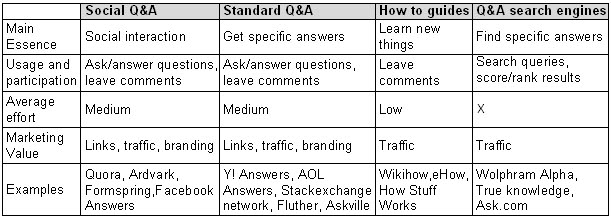
This table highlights the main purpose and value of each group, and we will see how we can use each group in a different way. The following article will mainly concentrate on the potential of the first two groups – social and standard Q&A sites. Also, the examples for each group include only general websites and not niche oriented (which are of course useful for the following techniques).
Now that we have clearer picture of the different kinds of Q&A sites, let's see the top seven reasons to use them, in order to improve our online acquisition efforts.
1. Recent Trend: people google more questions than generic keywords
It doesn't necessarily mean that the search volume of generic keywords is higher. But we can clearly see that there's an extreme increase in the search volume of question quarries, while at the same time a slight decrease in the search volume of generic primary keywords. The most interesting fact of this phenomenon is that it happens with keywords from the same topic.
To visualize this data, I chose some competitive generic keywords and related questions for those keywords. Than compared with Google KW Tool the difference between their search volumes in 2010.
For example, here's a comparison between the search volume of both generic and questions quarries for iphone keywords (it's "exact" search):
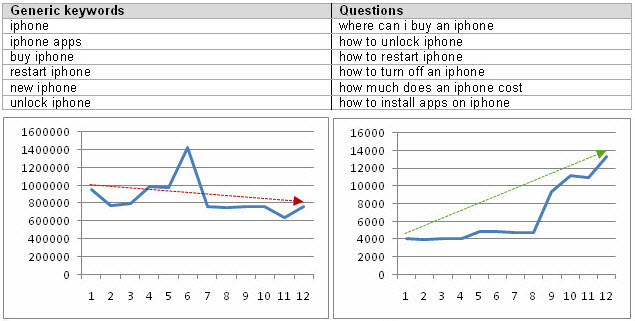
2. QA sites have become much more popular in the last year
Another evidence for this phenomenon, can be found in the fact that the traffic to QA and "how to" sites has been dramatically on the rise in the last year. Using Compete comparison, we can see the yearly change among some of these sites (unique visitors):
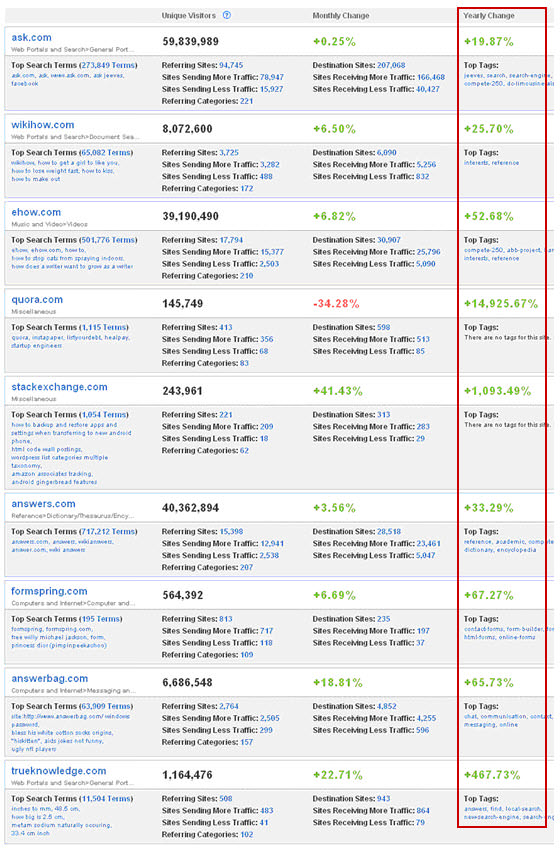
This is a very interesting trend, which can tell us a lot about the evolution of our search habits. What does it say about our web search psychology? How will this change impact the search engine's relevancy algorithm?
While the content farm update "erased" some of these sites, there will probably be new alternatives that will take their place (the next point can explain why).
3. Q&A pages ranked high in search results
It seems that pages from QA sites rank pretty well in organic search results. These pages are highly on-page optimized for the main keywords, well engaged by the users and are continuously updated by users. Here are some reasons why these pages might rank high:
- Search results variety – For each query, Google tends to offer different kinds of websites and content in the organic results, in order to diverse it's offering for users. So for example, if we will search "Michael Jackson", the search results will include links to different kinds of websites and content: Wikipedia, videos, music sites, magazine/news sites etc. Therefore, we can think of QA sites as an independent group of content, which might be ranked high for many queries.
- Frequently updated content - people always love to share their knowledge by answering questions related to their area of expertise. Whether in forums, professional communities or QA sites. People will always add new comments/answers to such pages. And if new content is frequently generated – you can be sure that Google will be there to index it and prioritize it over "dead" pages. Another aspect that definitely contributes to the richness of the content is user engagement. Things like commenting, scoring and voting make these pages very valuable for users.
- Well on-page optimization – most of these pages include various elements, which are an essential part of the on-page optimization factors (e.g. title, meta description, related tags and text). First of all, each one of these elements includes the main keywords of the specific question. Also, the internal linking structure supports the optimization level (e.g. "related questions" in each question page, "Recent answers" in user's profile, recent questions in main categories etc). For instance, take a look at a question page from Pro Webmasters:
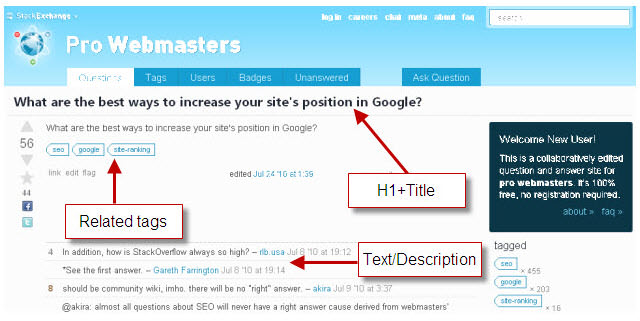
Knowing that, you can simply search for the most relevant questions related to your keywords and start dropping useful answers. Of course in addition to your answers, you can place links within the text in a relevant context. This way, you can drive some really targeted traffic and increase your backlinks profile. It's better to start with QA pages that are already ranked high in SERPs, since they already have existing and relevant traffic.
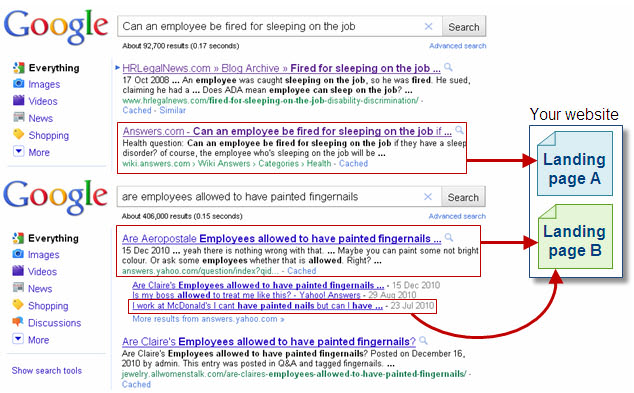
After dominating the 1st result page for your related terms, it's time to expand your sources by searching within the QA sites themselves. You can use Questionhub to save a lot of time. Questionhub is a giant aggregator that gathers questions from various QA sites around the web. Using Questionhub, you can find a lot of relevant Q&A pages in which you can leave answers and links to your site.
4. Great opportunity to diversify your backlinks profile
It's always recommended to include links from various kinds of websites in your backlinks profile, and not to concentrate just on one type (e.g. blogs, forums, news sites, social bookmarks/networks, static sites etc...). Basically there are two main reasons why you should get links from various sources:
- Your campaign will look more natural – if all your links come from blogs for example, it definitely won't look natural. More likely to be flagged by Google. It's much more natural that people will link from various spots rather than only one type of sites.
- Chances to gain more trust - Barry Schwartz referred to a video, in which Matt Cutts talked about the value of links from different segments of sites. In this video, Matt does seem to imply that Google is valuing links differently according to the type of the site.
If you expect to find some dofollow links with anchor text, you might be disappointed. But it doesn't matter as they will still be counted by Google (you can see them clearly in your webmaster tools account). And in any case, like I said before, it's a great opportunity to diverse your backlinks profile.
5. Pages that people prefer linking to
Let's say you wrote some really nice piece of content about car insurance for your blog. Since you want to make it useful for your users, you will link from it to external sources in a relevant context. But which pages will you probably link to? Will you link to some pages from commercial/corporation websites, or to some Q&A or "how to" pages? Let's assume for example that both options have the same relevancy to your content, and both deal with a narrow topic that you can't find on Wikipedia. I'm pretty sure that you will choose the 2nd option in such case.
Why do people prefer to link to such sources?
- Psychology – The action of linking from our site to a corporate or commercial website may be interpreted as an act of solitude or identification between us and that said company. This might make us rule it out in at point blank, sub consciously. Therefore, there are high chances that Q&A pages will gain natural links.
- Value – referring to Q&A and "how to" pages is much more valuable for users. Imagine yourself reading an interesting article and suddenly bumping into a link – wouldn't you prefer that it takes you to a neutral source that can assist you and teach you something new (or will expand existing knowledge)?
- Easy to find – as I wrote before, Q&A and "how to" pages are ranked well in SERPs because of their high level of on-page optimization. The most common thing to do if we want to find the appropriate source to link to - is to search for it. If I want to link from a paragraph that deals with cooking thanksgiving turkey for example, I might search for "how to cook a turkey" and will probably get results from Q&A and "how to" sites.
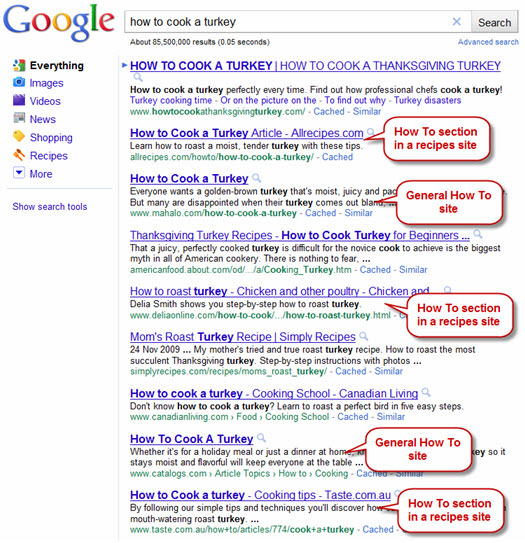
Build your own Q&A asset and gain natural links
The best way to benefit from this behavior and attract links, is to establish your own Q&A property. This kind of asset can be built on a separate domain or on a subdomain/subfolder in your existing domain. There are a lot of free open source solutions for building such platforms, just choose one (it's pretty ironic that I naturally found the Q&A site which I'm linking to right now, using the same technique I've described in the previous paragraph J).
After establishing the platform, you should think about a keyword strategy that will assist you in focusing your content. It's better to have a targeted Q&A section with questions related to specific and narrow topics, rather than general ones. So for example if you have a hotel - website, focus your content only on this field by covering all related long tails. If all questions will be related to a specific topic, it will encourage users to use your platform because they will treat it as an authority source to get answers (will you prefer to ask about hotels in a dedicated or general source?). It will also encourage expert users to leave answers (ego?), especially if they have a business or a website in the hotel industry that they wish to promote.
Now that we know which keywords we should focus on, it's time to fill them with some initial questions/answers and spread the word. Here's a quick action items list that will assist you with this mission:
- Publish about 10-20 initial questions that will include your main keywords. You can check in other popular Q&A sites what are the most common questions being asked, and imitate them. Also, it's highly recommended to concentrate on questions with low-middle competition in SERPs (only in the beginning of the process). A practical way to verify that, is to use the intitle:"your question" search operator in Google (more search operators that can help with narrowing your query).
- Leave detailed answers to these questions. But don't do it at once, use a couple of hours interval so it will look more natural. If you want it to look even more natural, you can use different identities instead.
- Drive traffic to your new section using social media (retweet new questions, share on facebook, email all your friends, link from your homepage, ask for reviews in forums etc). If it will bring value, I'm sure that shortly after launch, users will start asking and answering questions. And if the source will become an authority of a sort – links will soon follow.
6. Targeted traffic = better conversion
Imagine that you are a blackjack enthusiast, and next month you're traveling to Las Vegas for a vacation. Since this will be your first visit to Vegas, it's reasonable that you will search questions like "Which casino has the best blackjack game in Las Vegas". Chances are you will hit a Quora result:
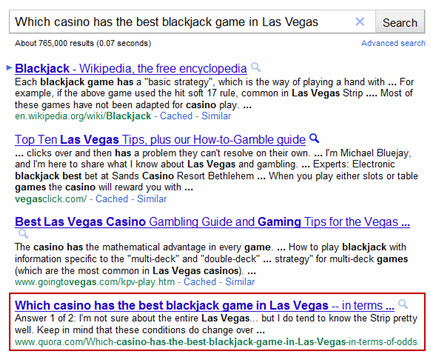
In this page you will find some very informative answers from anonymous users, who describe various casinos in Vegas and even provide some blackjack tactics. In fact, this answer is so informative and insightful, that you just can't ignore it. I bet you also won't ignore the single link within the content, which refers to a blackjack strategy page:
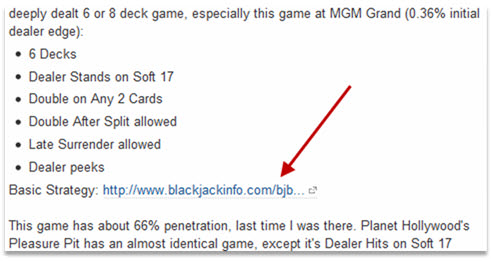
Now when you click on the link, chances are high that you will also click on the affiliate banner in this blackjack website and the rest is history. Let's see how the funnel of this process looks like:
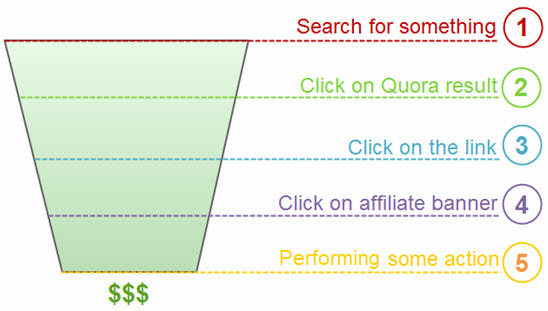
You can use this technique for both link building efforts and traffic generation. But if you are looking only for SEO benefits, you should concentrate mainly on getting such links. While these kinds of links may be worthless in terms of link juice as they are not followed, but they do have an alternative added value:
- Traffic – if you leave such detailed answers with links in more than one question, it can bring you some really nice and targeted traffic.
- Conversion – if the traffic is targeted to your niche, there are high chances that those users could become customers.
- Link from a Q&A site – although in certain cases they are not followed, they are still counted in the overall backlinks calculation. And like I've mentioned before – it's a great way to diverse your backlinks profile.
What is your experience with Q&A sites?
The techniques shared in this article can improve your SEO campaign, especially in a competitive niche. If all your competitors are doing pretty much the same – this is a great chance to be prominent and bring something different to the table.
Have you been using Q&A sites as part of your SEO tactics? How exactly? Or are you completely sure that these tactics don't have any value? Your thoughts are more than welcome.
Get Inspired Through Info Business Marketing

As a real world example of my info business, about nine years ago, I had an idea of a workout program for people. It started off as an idea I read on CNN, that traffic was 200% or 300% worse in the last couple of years. I thought, oh, people should have an exercise program while they’re in the car. I was talking to my personal trainer and he said, no, that would be a bad idea. Then I said, ok, and we started talking and he said, what about people who are in the office all day and sitting at their computers or watching TV. I said, yes, sounds great. You can also do the same with public domain ebooks, with a different approach.
So I literally went out and just wrote a quick little sales letter and then I told him. I said, figure out some exercises that would fit the bill for what we just wrote here. So he figured out the content part. That little e book is a simple way of getting out there and doing things and we sell it on ClickBank which is one of the marketplaces which handles all the logistics for you and will handle all the affiliate payments and the credit card costings and so forth. It’s a really good way to dip your toe in the water.
So that’s been selling for nine years straight now. It doesn’t make us a fortune but we don’t really market it anymore. But the last cheque I got was in the neighbourhood of $100 every two weeks or something like that. It’s not much but after nine years, it’s still pretty interesting. That’s one thing and so I’ve been helping him actually on a brand new program. He’s going to take his information for really advanced fitness people. His last name is Ball, so we’re going to call it The Big Ball’s Workout. It’s totally different.
It’s also a good segue into a point about differentiating and having something out there in the marketplace that has a good hook or a good angle. There’s obviously a whole lot of fitness information out there, so you have to pick off your market and then also come at it from a slightly unique way so that people can immediately get it. So for him, like I said his last name was Ball, so we instituted the Big Ball’s Challenge which is this workout which is so hard that you can’t do it and it plays to these guys’ manhood. Throughout the sales presentation, he calls them Cupcake and Princess. So it is kind of funny and plays against their ego and there’s a Hall of Fame if they can prove they actually completed the final advanced version of the Big Ball’s Workout.
So it’s got a unique place, a slightly unique hook in the marketplace. I don’t know how it’s going to do, we’re going to release it in the next couple of weeks, so we’ll see. That’s something that I’ve always been a big proponent of, that there has to be a unique aspect to it. So for my very first ones, the Instant Sales Letters that I wrote, that really took off, the unique hook there I call it a fish product. There is the old saying if you hand a man a fish, you feed him for a day or if you teach a man to fish, you feed him for a lifetime. That is kind of rubbish; people want the fish handed to them. That’s one way you can create that hook. So that’s what that product did. We’ve had a lot of success doing that.
Actually way back, my very first info business ideas was selling to cosmetic surgeons, dermatologists and plastic surgeons, helping them grow their practice. The very first thing that really took off was, I gave them different toolkits for all sorts of procedures , so it had pre done ads and postcards and scripts and press releases for liposuction or breast augmentation or all sorts of other procedures. People loved that; if you can do that for them that makes a big difference. That’s one of the hooks and one of the ways that you can create a different information product.
Believe it or not, you probably have a lot of this material on your computer. So if you’ve been doing anything and you’ve had success at it, there are a lot of other people out there, you can go back into your same marketplace. For me, I actually sold medical equipment so I worked with doctors every single day so that was my in. I have other clients who are actual doctors and they went back and sold to their profession because they’ve done different distinct things in their business, from how they trained their staff or how they market their practice or whatever the case is. To go back in your hard drive and start looking at things you’ve got on there, that could be the basis for a kit or an information product.
Study Internet Marketing From Top SEO Specialists. Visit http://www.melbourneseoservices.com
Monday, March 14, 2011
E-commerce: Using multivariate testing to increase sales 83.79%
Whenever I work with a Research Partner that is involved in e-commerce, I always come across problems with the product details page. A potential customer’s experience here should not be much different from the moment you pick up an item at a store and look at it. Imagine it:
- You’re browsing the aisles of your favorite store, going from category to category
- Finally, you see something that gets your interest
- The price doesn’t stop you from picking it up – you could buy it today, or come back next week when you get your paycheck
This is it…
- Do you put it in your cart or put it back?
- If you put it back, why? Does the price now start to look expensive seeing what you actually get compared to what you’d pay?
- Do you put it down and pick up a competing brand? Or do you look at both at the same time?
- Or do you decide it’s worth the money? Do you see yourself using it, feeling good about the purchase?
This happens on e-commerce sites just as much as it happens in stores. The only difference online is that the website is usually the one responsible for the final packaging/presentation of a product, whereas in a retail store they are mostly just responsible for placing the already packaged product on a shelf.
The challenge with e-commerce product template pages
We discovered this was an area of opportunity with one of our well-known e-commerce research partners last year. You could easily add one of their many products to the cart without having to understand all its details, but a number of visitors were actually visiting the product detail pages and then NOT converting.
Here’s what their product details page looked like: (to protect their privacy, I’ve re-created the page in wireframe format)
Major areas for testing
I used the MarketingExperiments Conversion Index to determine what to test:
Here is what I determined:
- Headline only contained the product name and nothing else (-v)
- The call to action comes before the product value (-v)
- Credibility indicators are out of the proximity of the call-to-action (+a, -v)
- Primary product benefits, guarantees and testimonials are trapped in tabs out of the primary eye path that require an extra click (-v, +f)
- Product imagery is generic and does little to add /support its value (-v)
- Page tone was very technical and not conversational (-v)
The preliminary research question
Was the product no longer worth the price once they looked at its value? Or were visitors simply not able to see all the true value of the product BECAUSE of the Web page?
The test was designed to answer these questions. Since these particular products were part of our Research Partner’s signature line, we wanted to be sure that the product didn’t need optimization before the presentation. This was our way of finding out.
Will a radical, clear presentation of existing product value result in an increase in sales?
A new presentation approach
I remember brainstorming with our lead designer, Charlie Moore (to whom I owe much of my success), on this one. How could we take the existing product value and represent it so that potential customers don’t have to search and click to figure out if they want to make the purchase?
It wasn’t just the value itself that wasn’t being presented properly; it was the tone of the page as well. We had to take what looked like a very technical page and turn it into a product presentation that an everyday consumer could connect with emotionally.
This is what we came up with: (to protect their privacy, I’ve re-created the page in wireframe format)
Major changes:
- Used the primary product benefit in combination with product name for the headline (+v)
- We moved ALL the product benefit, guarantee and feature copy to the primary eye-path (+v, -f)
- All un-related links were moved to the header/footer area (-f)
- Supporting content found in the tabs were moved into the supporting column (+v)
- We used visual indicators to support value for visitors that like to quickly scan and improve the tone
- We focused each header on a primary benefit and supported with feature specific copy
- The call to action and product price was moved after the product value (+v)
- Credibility indicators were placed in closer proximity to the call to action (-a, +v)
Note: The only content we substituted in this treatment was visual indicators (for the generic imagery) and page colors. The rest of the content was available in some form or fashion on the control.
Promising Results
It only took us ten days to discover that there was a difference between these two pages statistically. The treatment outperformed both the control and double control with an 83.79% increase in product sales (not just add to carts).A double control is a technique high-traffic, high-converting use (essentially splitting traffic to two identical control pages as well as a set of treatments) to determine normal variance as well as defend against validity threats, such as instrumentation effect.
I wanted to run some follow-up tests to try and understand exactly which elements had the most impact on these particular consumers (was it the visual indicators, the testimonials, etc.?) but ultimately I learned that the combination of these elements, all related to quick, clear product presentation, resulted in more sales – sometimes the most important things you can learn from a multivariate test.
Just like in re-creating that perfect cup of coffee, I desire to try and re-create the experience by understanding just how much cream, sugar and black coffee (at what concentration) goes into that perfect, addicting taste with further testing. But at this point, we had driven a significant sales gain, and the battle was won for the day.
Are you paying attention to your product pages?
If you’re in e-commerce, pay attention – The product details page template often times has the most influence on the product purchase decision.
While customer demographics, interests and motivations will vary, what remains constant is that customers must be able to quickly and clearly judge if your product is worth the price you put on it. The more roadblocks you place in their way to making this decision, the more likely they will run away from your product prematurely.
Related Resources
What Else Can I Test…On My E-commerce Or Lead Generation Website?
E-commerce Shopping Carts: How a redesigned checkout process led to 13% increase in conversion rate
Homepage Optimization: Creating the best design to quickly meet multiple visitors’ needs
What Else Can I Test to Reduce Shopping Cart Abandonment Rate?
















